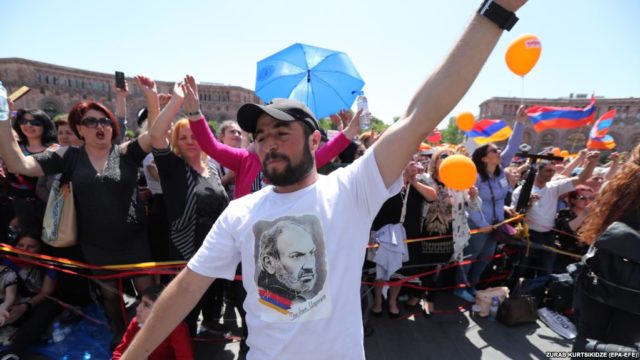
Armenian Events Spark Public Activism and Repression in North Caucasus
Publication: Eurasia Daily Monitor Volume: 15 Issue: 72
By:

The so-called “Velvet Revolution” in Armenia (see EDM, April 23, May 3) is highly unlikely to shift the country’s orientation away from Moscow in the near term, particularly given the country’s geopolitical position. And yet, the recent Armenian events may have an even greater impact on developments within the Russian Federation than did the earlier revolutions in Georgia and Ukraine. That is because the Armenians were animated by many of the same issues now agitating people inside Russia: the sense that they are losing their political rights with the cancelation of elections by the authorities and the feeling that they have no other choice but to take to the streets to press their demands on the powers that be (see EDM, April 24). Armenia showed that a population infuriated by such problems can succeed against even entrenched power; and that is a lesson the Kremlin does not want its subjects to learn.
The first place where this Armenian lesson is likely to matter is in the restive North Caucasus. There, ever more people are taking to the streets to call for the restoration of direct elections of governors and mayors, something they have lost in the last few years under Vladimir Putin (Onkavkaz.com, May 1). Up to now, none of these separate movements has won a victory over Moscow’s imposition of officials from the outside (see EDM, November 17, 20, 2017; February 28, 2018); but Armenia shows that, at least in principle, such a victory is possible. Though, to succeed, people need to be prepared to protest again and again, and leaders must emerge within their ranks to press their case against a repressive state—even if that state chooses, as the Putin regime has, to become more repressive in response. Crackdowns will work for a time, but it will almost inevitably radicalize more people, yet another lesson from Yerevan.
Because the Armenian events have not led to a change in Yerevan’s geopolitical stance, most Russian commentators have ignored these potential domestic implications altogether or suggested that Vladimir Putin, far more prepared to shed blood than the former Armenian leader Serzh Sargsyan, will manage to contain any opposition (Ekho Mosvky, April 27; Svoboda.org, April 24). But they have also ignored something else: there are significant ethnic-Armenian communities in many of the North Caucasus republics, and these communities, almost all of which have supported the change of power in Yerevan, may serve as a channel for the spread of Armenian ideas to the region.
In Vladikavkaz, the capital of North Ossetia–Alania, for example, the local Armenians organized a flash mob in support of Armenian protest leader (and current prime minister) Nikol Pashinyan. Similar developments apparently occurred in other parts of the North Caucasus where ethnic Armenians form a small but politically active portion of the population. Among these are the Armenians in Dagestan, Ingushetia, Kabardino-Balkaria, Karachaevo-Cherkessia, Chechnya and Adygea, as Valery Dzutsati points out in a commentary for Radio Svoboda’s North Caucasus portal (Kavkazr.com, May 1).
But it is not just the Armenian diasporas who are playing a role. Increasingly, as Moscow has sought to come to terms with what has happened in Yerevan and to its client Sargsyan, officials and commentators are saying that the peaceful change of power can be a good thing. Many—especially in the North Caucasus—may find this message quite attractive given their problems with current Moscow-imposed leaders and their desire to avoid the kind of repression Moscow would almost certainly respond with if there were any violent moves against them (Lebedev-ldpr.livejournal.com, April 23).
As Dzutsati, a North Caucasus scholar at RFE/RL, notes, “the distinctive part of the peaceful change of power in Armenia was the unwillingness or impossibility for the chief of state to use force against peaceful actions of protest” against him. “In a comparatively small society, the murder of some Armenians by others could become fatal for a government, especially if the protest remained peaceful.” That has obvious implications in the North Caucasus if not for Russia as a whole: “The impossibility of shooting at ‘one’s own’ is characteristic for small North Caucasian societies where all know one another.” If force were going to be used, it would have to come from the outside, transforming any such application of violence into the latest colonial war and radicalizing populations Moscow has hoped to pacify. That is something Putin almost certainly will want to avoid lest he face another North Caucasus revolt in his new term in office (Kavkazr.com, May 1).
What remains an open question, Dzutsati and others suggest, is whether North Caucasians, beginning with peaceful protests will not quickly shift over to violence. The Armenians avoided doing so and won out as a result. That shows what the North Caucasians might able to achieve as well. But their history over the last three decades also suggests an alternative: Moscow may seek to provoke them because the Kremlin will find it far easier to justify crushing an armed revolt than going after peaceful protesters. Those around Putin are probably making those types of calculations even now, raising the prospects that Moscow-backed provocations and Moscow-imposed repression become increasingly likely in the days and weeks ahead.



